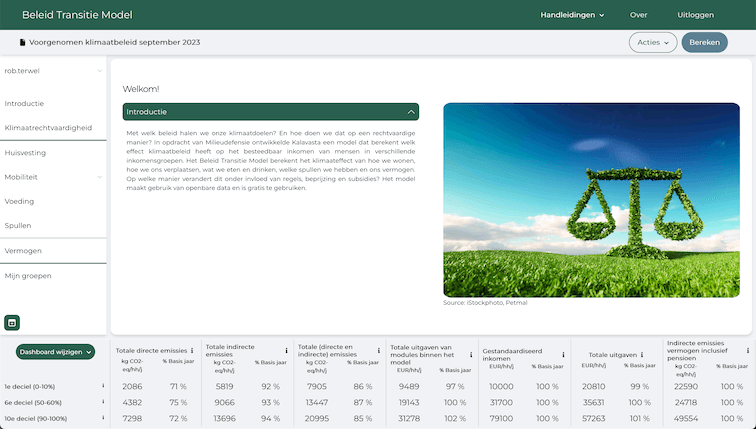The Beleid Transitie Model (BTM) (2023-now)
We built an open source and open data model which enables users tp explore the effects of climate policy on household expenses and emissions for different income groups or user-specified households

Why a new tool on Dutch climate policy?
In 2023, the NGO Friends of the Earth Netherlands (Milieudefensie) initiated the development of the Beleid Transitie Model (BTM), or policy transition model. The aim of the model is to gain insight in how climate policy affects different income groups in the Netherlands, both on a cost and an emission level. By using this tool, one should be able to determine whether the current policy is ‘fair’ or ‘just’, and to explore different policy routes towards a fair distribution of climate policy costs for income groups.
What does the BTM do?
The BTM is built on consumption numbers (mainly) from the national statistics bureau, CBS. For ten different income groups, the model calculates the emissions and costs for energy in households, transport (cars, flights, public transport), food, stuff (such as clothing, household equipment, and building materials) and assets. Depending on the newly developed policy, these income groups will change their behavior. It differs per module how the income groups will adapt. For the simpler modules such as public transportation and flying, we used price elasticities to adapt future behavior of income groups. For more difficult and intricate modules, such as housing and car transport, we used a detailed investment analysis for the different income groups.
The calculations described above are for the average of the income groups. However, no household is average. Therefore, we also implemented a user-specified household which will also change under the policy. In this way, it is possible to identify for your own situation how climate policy could impact your expenditures and emissions.
Have your already looked at the effect of current policies?
We have looked at all climate policy which has been implemented or is on course to be implemented (status: September 2023), which is sufficiently detailed, quantitative and directly affects the consumer. We then find that in general and on average household expenses across income groups stay roughly the same (slight decrease in lower income groups, slight increase in higher income groups), while emissions go down, albeit not enough for the 2030 targets. This outcome, insofar as results are comparable, is in very good agreement with PBL’s latest Climate and Energy Outlook 2023 (KEV2023).
What does the BTM say about climate justice with regard to current policies?
There are several ways in which it can be judged whether climate policy is just. In this project, we made use of the Climate equity reference calculator developed by the Stockholm institute. It divides the task of reducing emissions for the different income groups based on the concepts of responsibility and capability. Higher income groups on average emit more greenhouse gases (responsibility) and have more income to invest in new technologies to reduce their emissions (capability). Based on the proposed climate policy until September 2023, we find that the average reduction in greenhouse gases is rather similar for the different income groups. Therefore, based on the responsibility and capability of income groups, the higher incomes should be triggered more by new policy measures to reduce their footprint. The more detailed report can be found on the website of the BTM.
Where can I learn more about the model?
The model is open access and free of charge, which means that anyone can use it to explore Dutch climate policy and its effect on different income groups. The model can be accessed through the website beleidtransitiemodel.nl. A user guide for the model as well as technical documentation are available within the model, too.
